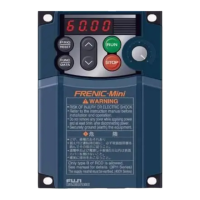iii
Precautions for Use
Driving a 400 V
general-purpose
motor
When driving a 400 V general-purpose motor with an inverter using
extremely long wires, damage to the insulation of the motor may occur. Use
an output circuit filter (OFL) if necessary after checking with the motor
manufacturer. Fuji motors do not require the use of output circuit filters
because of their reinforced insulation.
Torque
characteristics and
temperature rise
When the inverter is used to run a general-purpose motor, the temperature
of the motor becomes higher than when it is operated using a commercial
power supply. In the low-speed range, the cooling effect will be weakened,
so decrease the output torque of the motor. If constant torque is required in
the low-speed range, use a Fuji inverter motor or a motor equipped with an
externally powered ventilating fan.
Vibration
When an inverter-driven motor is mounted to a machine, resonance may be
caused by the natural frequencies of the machine system.
Note that operation of a 2-pole motor at 60 Hz or higher may cause
abnormal vibration.
* The use of a rubber coupling or vibration-proof rubber is recommended.
* Use the inverter's jump frequency control feature to skip the resonance
frequency zone(s).
In running
general-
purpose
motors
Noise
When an inverter is used with a general-purpose motor, the motor noise
level is higher than that with a commercial power supply. To reduce noise,
raise carrier frequency of the inverter. Operation at 60 Hz or higher can also
result in higher level of wind roaring sound.
High-speed
motors
If the reference frequency is set to 120 Hz or more to drive a high-speed
motor, test-run the combination of the inverter and motor beforehand to
check for safe operation.
Explosion-proof
motors
When driving an explosion-proof motor with an inverter, use a combination
of a motor and an inverter that has been approved in advance.
Submersible
motors and pumps
These motors have a higher rated current than general-purpose motors.
Select an inverter whose rated output current is higher than that of the
motor.
These motors differ from general-purpose motors in thermal characteristics.
Set a low value in the thermal time constant of the motor when setting the
electronic thermal overcurrent protection (for motor).
Brake motors
For motors equipped with parallel-connected brakes, their power supply for
brake must be supplied from the inverter’s primary circuit. If the power
supply for brake is connected to the inverter's output circuit by mistake, the
brake will not work.
Do not use inverters for driving motors with series-connected brake coils.
Geared motors
If the power transmission mechanism uses an oil-lubricated gearbox or
speed changer/reducer, then continuous motor operation at low speed may
cause poor lubrication. Avoid such operation.
In running
special
motors
Single-phase
motors
Single-phase motors are not suitable for inverter-driven variable speed
operation. Use three-phase motors.
Environ-
mental
conditions
Installation
location
Use the inverter within the ambient temperature range from -10 to +50°C.
The heat sink and braking resistor of the inverter may become hot under
certain operating conditions, so install the inverter on nonflammable
material such as metal.
Ensure that the installation location meets the environmental conditions
specified in Chapter 8, Section 8.4 "Operating Environment and Storage
Environment."

